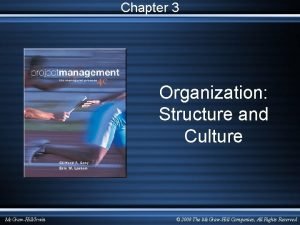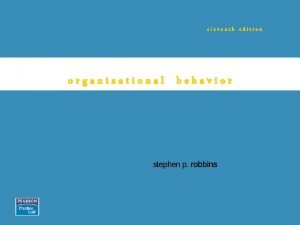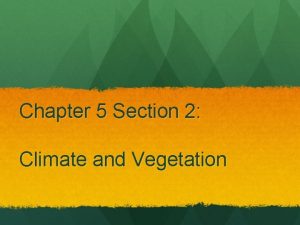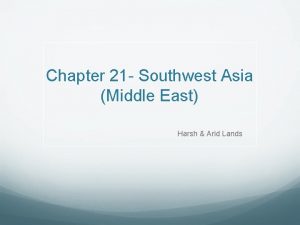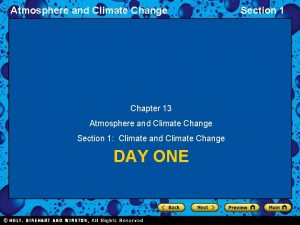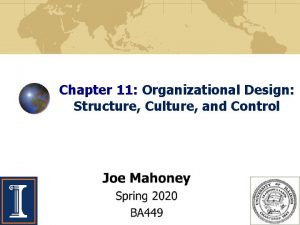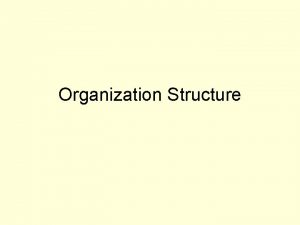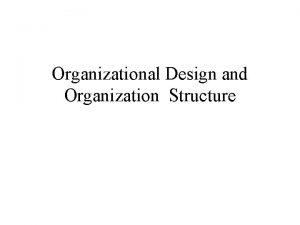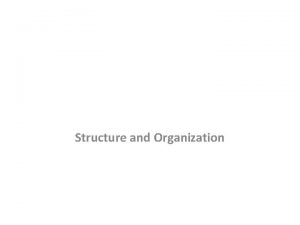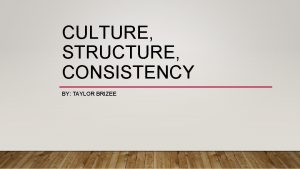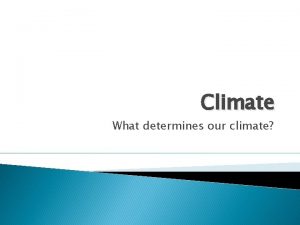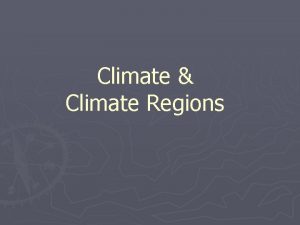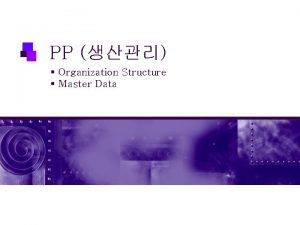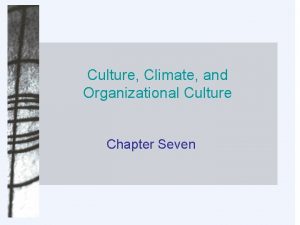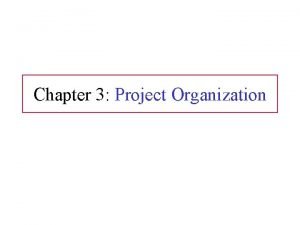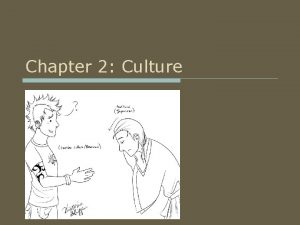Chapter 13 Organization Savvy Structure Culture and Climate




































- Slides: 36

Chapter 13 Organization Savvy: Structure, Culture, and Climate

Chapter 13 Objectives • Discuss what organizational structures are and why • • they exist. Explain who has authority in an organization and how authority originates. Describe how organizational structure affects communication. Identify signs that signal future organizational changes. Explain corporate cultures and climates and their importance. Chapter 13 Organization Savvy: Structure, Culture, and Climate 2

Why Organizations Need Structure • Structure is the relationship among parts. • An organization has an extremely important structural component: its culture and climate. • Companies are experimenting with radical new ideas concerning structure and culture to spark innovation and allow a more rapid response to changing market demands. Chapter 13 Organization Savvy: Structure, Culture, and Climate 3

Why Organizations Need Structure (cont. ) • Organization structure greatly impacts organization and human relations systems, dictating: § Managerial style, leadership, and power § Protocol and goals § Diversity and decision making § Teamwork and conflict management § Ethics • Organization structure affects learning and innovation skills as well as life and career skills. Chapter 13 Organization Savvy: Structure, Culture, and Climate 4

Authority and How It Originates • An organization’s structure defines who has authority. • Originally, organizational structure developed around the chain of command. • The chain of command is the direction in which authority is exercised and policies and other information are communicated to lower levels. • The idea of the chain of command developed in the military and is prevalent in today’s organizations. Chapter 13 Organization Savvy: Structure, Culture, and Climate 5

Figure 13. 1 Chain of Command (not all ranks shown) Generals Majors Captains Lieutenants Sergeants Upper level management Middle level management Lower level management Corporals Privates Military Chapter 13 Organization Savvy: Structure, Culture, and Climate Rank and file Presidents Vice presidents Regional managers Assistant managers First-line supervisors Lead employees Nonsupervisory employees Business 6

Authority and How It Originates (cont. ) • New structures have developed as organizations have become larger and more complex. • The basic pyramidal hierarchy no longer meets all organizational needs. • The most efficient structure depends on: § The size of the organization § Whether it provides a service or produces a product § The number of different products or services it offers Chapter 13 Organization Savvy: Structure, Culture, and Climate 7

Authority and How It Originates (cont. ) • Formal structure can be organized by: § Function (what each department does) § Geographic area § Customer § Product • Large, complex organizations may use a variety of these structures, depending on their needs. Chapter 13 Organization Savvy: Structure, Culture, and Climate 8

Authority and How It Originates (cont. ) • Complex organizations have developed other structures to enhance organizational effectiveness. § Some use a line and staff structure. § Others use a matrix structure. § Still others mix the two. • Organizations are also trending toward modular organizations and virtual organizations. Chapter 13 Organization Savvy: Structure, Culture, and Climate 9

Authority and How It Originates (cont. ) Line and Staff Structure • In line and staff structures: § Line employees are directly involved in production activities. § Staff employees support line employees through advice and counsel on a variety of subjects in their areas of expertise. Chapter 13 Organization Savvy: Structure, Culture, and Climate 10

Authority and How It Originates (cont. ) Line and Staff Structure (cont. ) • Problems can arise from line and staff relationships: § Staff members usually have no authority to force line employees to cooperate. § Staff people must rely on persuasion to convince line workers that staff instructions should be followed. § Some staff members are given functional authority— authority to make decisions in their area of expertise and to overrule line decisions. Chapter 13 Organization Savvy: Structure, Culture, and Climate 11

Authority and How It Originates (cont. ) Matrix Structure • A matrix structure uses groups of people with expertise that are temporarily assigned to a project from other parts of the organization. § This structure is sometimes called a project structure. § The project has its own supervisor and can last a few weeks or a few years. Chapter 13 Organization Savvy: Structure, Culture, and Climate 12

Authority and How It Originates (cont. ) Matrix Structure (cont. ) • Difficulties with matrix structures: § The individual assigned to head the temporary team may have no formal authority or control over the rest of the group. § Power struggles may erupt as a result. § In this situation, the leader must ask formal authority over the group. Chapter 13 Organization Savvy: Structure, Culture, and Climate 13

Authority and How It Originates (cont. ) Modular Organization • In a modular organization, a company keeps the business activities it can perform faster, better, and more cheaply than other organizations and outsources its remaining business activities. • Disadvantages of this organization: § Some loss of control occurs. § Suppliers can sometimes become competitors. Chapter 13 Organization Savvy: Structure, Culture, and Climate 14

Authority and How It Originates (cont. ) Virtual Organization • Virtual organizations are part of a network in which companies share costs, skills, capabilities, and markets. • Members of a virtual organization may join to satisfy the needs of a specific customer and then go their separate ways. Chapter 13 Organization Savvy: Structure, Culture, and Climate 15

Authority and How It Originates (cont. ) Virtual Organization (cont. ) • Disadvantages of virtual organizations: § The quality of the work product is harder to control. § Opinions on what a quality work product is will likely differ. § Coordinating the work of independent organizations can be a challenge. § The project manager may have to develop working relationships repeatedly as virtual team members change. Chapter 13 Organization Savvy: Structure, Culture, and Climate 16

Authority and How It Originates (cont. ) Distribution of Authority • Two common forms of authority distribution: § Centralized—those high up in the organization closely hold authority and are responsible for making all major decisions § Decentralized—important decisions are made at a lower level and authority is delegated Chapter 13 Organization Savvy: Structure, Culture, and Climate 17

Authority and How It Originates (cont. ) Span of Control • Span of control is the number of people that an individual can supervise. • Span may be either tall or flat. Chapter 13 Organization Savvy: Structure, Culture, and Climate 18

Figure 13. 3 The Span of Control Can Be Tall or Flat Tall Structure Chapter 13 Organization Savvy: Structure, Culture, and Climate 19

Figure 13. 3 (cont. ) The Span of Control Can Be Tall or Flat Structure Chapter 13 Organization Savvy: Structure, Culture, and Climate 20

Authority and How It Originates (cont. ) Span of Control (cont. ) • Broaden span of control by delegating authority to others within your group. • Broadening span of control can: § Lessen red tape § Increase morale § Increase job satisfaction Chapter 13 Organization Savvy: Structure, Culture, and Climate 21

How Structure Affects Communication • Formal communication is controlled by the chain of command. • Formal communication varies in: § The direction it flows § Whether it’s one-way or two-way § Its chance of distortion • In any organization, communication will flow downward, upward, or horizontally (sideways). Chapter 13 Organization Savvy: Structure, Culture, and Climate 22

How Structure Affects Communication (cont. ) • Downward communication: § Begins at higher levels and flows downward § Examples: meetings, manuals, policies, memos • Downward communication can become distorted: § Long messages not in writing tend to be forgotten or misinterpreted. § Sometimes so many messages are received that a communications overload results. Chapter 13 Organization Savvy: Structure, Culture, and Climate 23

How Structure Affects Communication (cont. ) • Upward communication: § Begins at lower levels and goes to higher levels § Examples: memos, suggestions, grievances, surveys, meetings • Upward communication can also become distorted: § Subordinates who must deliver unpleasant messages may misrepresent situations for fear the receiver may blame the messenger. Chapter 13 Organization Savvy: Structure, Culture, and Climate 24

How Structure Affects Communication (cont. ) • Horizontal communication: § Occurs between individuals at the same level in the organization § Examples: telephone conversations, e-mail, meetings • Horizontal communications can be distorted when: § Messages are not clear § Perceptions differ § Attitudes get in the way Chapter 13 Organization Savvy: Structure, Culture, and Climate 25

How Structure Affects Communication (cont. ) • Communication within organizations is either one- way or two-way. • Two-way communication is communication in which feedback is received. § Examples: meetings, telephone conversations, e-mails § Slower and less orderly than one-way communication § More accurate than one-way communication Chapter 13 Organization Savvy: Structure, Culture, and Climate 26

How Structure Affects Communication (cont. ) • One-way communication takes place with no feedback from the receiver. § Examples: videotaped lectures, memos § Used frequently because it is quick, easy to generate, and orderly • Informal communication is the most common type of communication that occurs in organizations. • It does not follow the formal channels of communication but travels through the grapevine. Chapter 13 Organization Savvy: Structure, Culture, and Climate 27

How Structure Affects Communication (cont. ) • The grapevine is an informal, person-to-person means of circulating information or gossip. § Satisfies social needs § Clarifies formal orders § Used as a release for feelings/concerns § Used primarily for its speed • Because of its unreliability, it requires caution, ethics, and maturity. § Messages are distorted, exaggerated, incomplete, or even totally wrong. Chapter 13 Organization Savvy: Structure, Culture, and Climate 28

Why Structures Change • Reasons why organizations change: § Products complete their life cycles—they become obsolete and disappear as fresh products enter the market. § New markets open and old markets fade away. § Competition or the lack of it increases or decreases demand. § Personnel changes may necessitate adjustments. Chapter 13 Organization Savvy: Structure, Culture, and Climate 29

Why Structures Change (cont. ) • To respond to these types of changes, businesses frequently reengineer. § Business process reengineering is the fundamental rethinking and radical redesign of business processes to achieve dramatic improvements in measures of performance, such as cost, quality, service, and speed. § During the process of reengineering the business system, an organization’s structure often has to be modified. Chapter 13 Organization Savvy: Structure, Culture, and Climate 30

The Importance of Culture and Climate • Organizational culture is the combined beliefs, values, ethics, procedures, and atmosphere of an organization. • The culture determines what goals the organization wants to accomplish and how it will go about accomplishing them. • Subcultures may exist in an organization in different departments or functions. Chapter 13 Organization Savvy: Structure, Culture, and Climate 31

The Importance of Culture and Climate (cont. ) • Phegan’s five levels of organization culture: 1. Equipment and Other Physical Objects ○ This level defines the dress as well as the structures in which members work and live and can be readily observed. 2. The Systems That Coordinate Equipment ○ This level includes operating systems, processes, procedures, and methods. 3. The Authority Structure That Connects Systems with People ○ Key aspect of this level is power and control, including authority, competition, organizational structures, markets, information, productivity, and profits. Chapter 13 Organization Savvy: Structure, Culture, and Climate 32

The Importance of Culture and Climate (cont. ) • Phegan’s five levels (cont. ): 4. Communication That Connects People ○ Communication includes listening, understanding, dialogue, relationships, and teamwork. 5. Experience—Creating Motivation and Trust ○ This includes feelings such as trust, caring, safety, satisfaction, pride, and engagement. Chapter 13 Organization Savvy: Structure, Culture, and Climate 33

The Importance of Culture and Climate (cont. ) • Organizational climate is the environment created by the managerial style and attitudes that pervade an organization. • Organization leaders set the tone for the climate. • Climate can affect things such as productivity and creativity. Chapter 13 Organization Savvy: Structure, Culture, and Climate 34

Key Terms • Chain of command • Virtual organization • Pyramidal hierarchy • Centralized organization • Line and staff structure • Decentralized • Functional authority • Matrix structure • Modular organization Chapter 13 Organization Savvy: Structure, Culture, and Climate organization • Span of control • Formal communication 35

Key Terms (cont. ) • Downward • • communication Upward communication Horizontal communication Two-way communication One-way communication Chapter 13 Organization Savvy: Structure, Culture, and Climate • Informal communication • Grapevine • Life cycle • Business process reengineering • Organizational culture • Organizational climate 36
 Chapter 3 organization structure and culture
Chapter 3 organization structure and culture Climate change 2014 mitigation of climate change
Climate change 2014 mitigation of climate change Savvy food safety
Savvy food safety Student savvy
Student savvy Savvy saving seniors
Savvy saving seniors Savvy online shopping
Savvy online shopping People with political savvy make decisions that:
People with political savvy make decisions that: Body language savvy
Body language savvy Edl positive school culture & climate
Edl positive school culture & climate Popular culture examples
Popular culture examples Fed-batch
Fed-batch Difference between american and indian culture
Difference between american and indian culture Stab and stroke culture
Stab and stroke culture Folk culture and popular culture venn diagram
Folk culture and popular culture venn diagram Folk cultures are spread primarily by
Folk cultures are spread primarily by Urease test
Urease test Folk culture and popular culture venn diagram
Folk culture and popular culture venn diagram Anaerobic gaspak
Anaerobic gaspak Lawn culture
Lawn culture Surface culture deep culture and esol
Surface culture deep culture and esol Point-by-point arrangement
Point-by-point arrangement Sociologists define a symbol as
Sociologists define a symbol as Batch culture vs continuous culture
Batch culture vs continuous culture Individualistic culture definition
Individualistic culture definition Subculture group
Subculture group In an inert organizational culture,
In an inert organizational culture, Characteristics of quality culture
Characteristics of quality culture Seven elements of culture
Seven elements of culture Do organization have uniform culture
Do organization have uniform culture Process organization in computer organization
Process organization in computer organization Chapter 9 section 2 climate and vegetation
Chapter 9 section 2 climate and vegetation Chapter 21 section 2 climate and vegetation
Chapter 21 section 2 climate and vegetation Chapter 13 atmosphere and climate change section 1
Chapter 13 atmosphere and climate change section 1 Chapter 13 atmosphere and climate change
Chapter 13 atmosphere and climate change World geography today
World geography today Organizational design: structure, culture, and control
Organizational design: structure, culture, and control Ales force structure
Ales force structure
